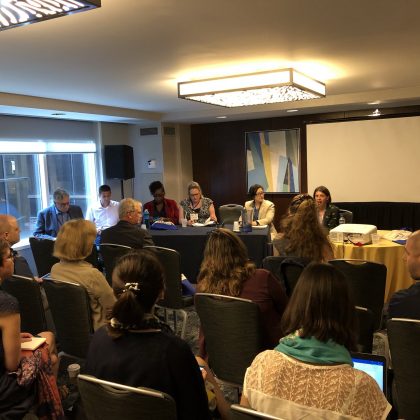How to Write A Great Peer Review
Reviewers often ask the editorial team at Law & Social Inquiry for tips on writing peer reviews. Here are what I see as four key attributes of reviewer reports that are most valuable to editors and authors.
Transparent.
A strong peer review is appropriately open and honest with the journal’s editors. The reviewer has a responsibility to disclose to the editors if there are any potential conflicts of interest or if there are circumstances that limit the reviewer’s ability to assess the merits of a manuscript.
At LSI, we don’t assign anyone to review a manuscript who is a colleague or co-author of the author. But there are situations short of this kind of direct conflict that may compromise our goal of truly double-blind peer review that do not, by our internal rules, necessarily prevent a person from writing the review. A reviewer may know or suspect the identity of the author. Or the reviewer may have had some interaction with the author—they might have been on a conference panel together or the reviewer might have read an earlier version of the manuscript.
LSI is committed to a double-blind peer review process. But we’re also aware that in some areas of scholarship the pool of scholars best qualified to evaluate a manuscript may be limited, making it inevitable that some excellent prospective reviewers will be aware of the scholarship of others working in their field. Online posting of conference papers and draft work makes it increasingly difficult for works-in-progress to be completely anonymous. Although professionalism and respect for the peer-review process requires reviewers to refrain from taking the initiative to find out more about a manuscript they have agreed to review, prior knowledge about a manuscript is sometimes unavoidable.
When complicating factors such as these exist, the best solution is transparency. The reviewer should use the confidential comments to the editor option to explain the potential conflict.
Another way in which a reviewer can be transparent with the editors (and, when appropriate, with the author) is to disclose relevant limitations in the reviewer’s knowledge or experience that might affect the reviewer’s ability to assess the manuscript. If the manuscript relies on a methodology with which the reviewer is not familiar and is unable to assess, the report should note this. If the manuscript explores a topic area or a jurisdiction on which the reviewer has limited knowledge, this too should be noted in the reviewer report. In an interdisciplinary journal of global coverage such as LSI, we often rely on different reviewers to assess different components of a given manuscript. We want to see, for instance, what an expert on human rights who works with qualitative methods makes of a manuscript that claims to tell us something new about human rights using quantitative methodology. We want to see if a manuscript that explores alternative dispute resolution in China resonates with a scholar who works on alternative dispute resolution in the United States. In situations such as these, it’s important to remind the editors and inform the author if there are limits to the reviewer’s knowledge that might affect their assessment.
Critical.
The great value of the peer review process is that it challenges authors to make their scholarship better. The process is designed not only to select which manuscripts will be published, but also to make these manuscripts better, whether an article is accepted or not. The best peer reviews spur the author to think about things the author might have missed, or to reconsider underdeveloped or under-substantiated claims. To achieve this, a review needs to be critical.
Perhaps the least helpful reviews we receive are those that offer little more than what amounts to a thumbs up: a sentence or two of compliments and a recommendation to publish. Perhaps the manuscript was so mind-blowingly brilliant that nothing more can be said. But I’ve yet to see such a manuscript. It’s extremely rare for submissions to LSI to be accepted upon first review; nearly all of our published articles have gone through at least one round of revise-and-resubmit.
This is not to say that reviews should be gratuitously critical or harsh. This is of course not what we want. Nor is it to say that compliments don’t belong in reviewer reports. Strengths should be identified and praised. But the peer review process is like a good academic workshop: it works best when it’s not only supportive but also substantive and challenging.
Displays Intellectual Empathy.
The best peer reviewers engage with a manuscript on its own terms. The reviewer doesn’t say (in so many words): “I would have written the manuscript differently and because the author did not write the manuscript this way, it should be rejected.” Good reviewers are able to separate themselves from the manuscript, place themselves into the project as the author conceives it, and engage it (critically) from that perspective.
An outgrowth of the ability to see the project from the inside is that the best peer reviews balance criticism with constructive suggestions. They offer what I call a revision blueprint: a set of recommendations that present ways in which an author might address the manuscript’s weaknesses. A sensible and feasible revision blueprint, even if contained in a sharply critical peer review, allows the editor to see beyond the critiques and to think about how the revise-and-resubmit process might make a manuscript in a potentially publishable article.
Generous.
The best peer reviews are critical, but they are also generous. Whatever strengths there are to the manuscript, the reviewer should identify and praise. It’s important that the author and the editors know what resonated with the reader. When describing flaws in the manuscript, the reviewer should be kind. Be honest; don’t say nice things just to say nice things. But the reviewer should never forget that their words will be read by an author who put a great deal of work into the manuscript and should engage with the work in a way that is critical but respectful and, above all, humane.
If the article has flaws that the reviewer believes are fatal to that article—or at least disqualifies it from consideration in the journal to which it was submitted—the reviewer should say so. But the reviewer should also allow for the possibility that what they see as a fatal flaw may be, at base, a difference of approach or a reasonable difference of opinion. The very best reviewers don’t only identify the limits of a manuscript, they also acknowledge their own preferences, biases, and the limits of their knowledge.
Christopher W. Schmidt is the Editor of Law & Social Inquiry. Learn how to submit or review.






